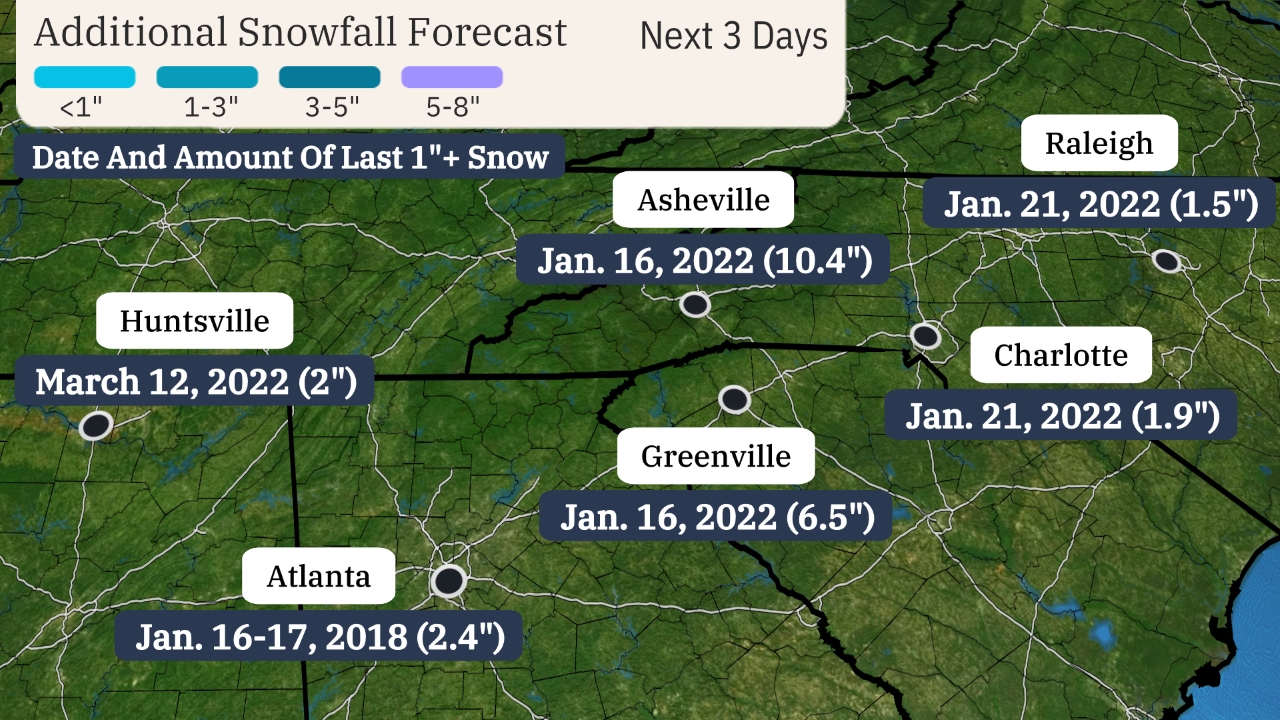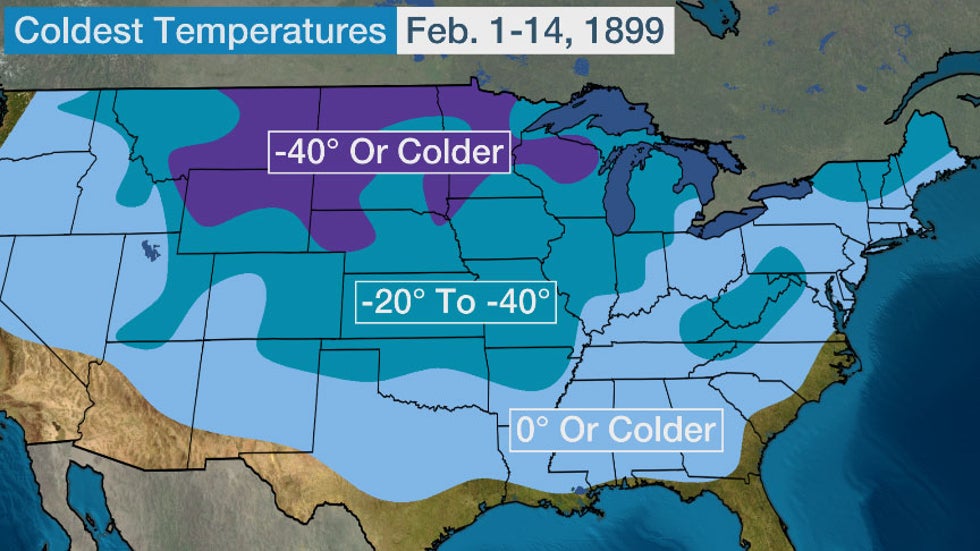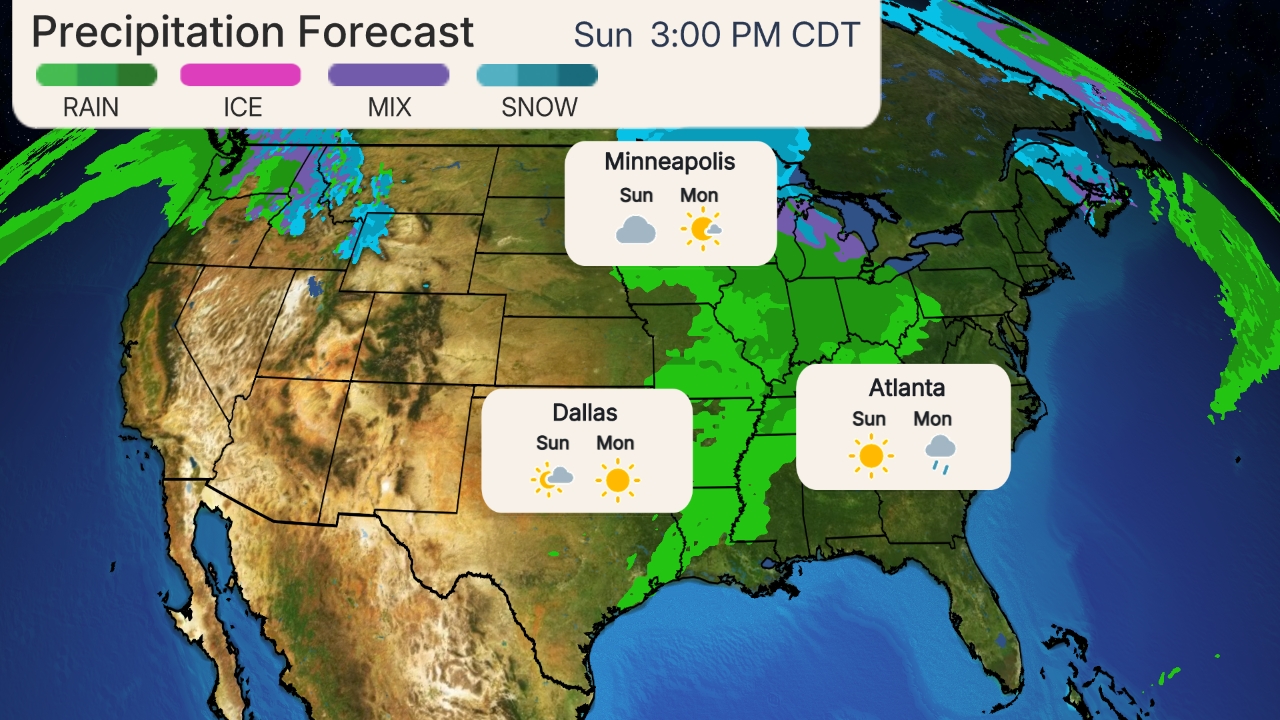Jonathan Erdman
A blast of arctic cold air in the nation's mid-section beginning this weekend is expected to linger into mid-February, but it's not expected to break many records by late winter standards.
This cold outbreak will empty out of western Canada beginning Saturday and will ooze gradually south and eastward into next week.
(MORE: Forecast Details on the Arctic Outbreak)
Subzero lows are possible as far south as the Ohio Valley and central Plains.
The typically coldest spots in the upper Midwest and Northern Plains may plunge into the 20s, even 30s below zero at times.

Temperatures during this outbreak may be up to 40 degrees colder than average in parts of the nation's northern tier.

Wind chills could dip as low as minus 50 degrees in some areas.
The Record Bar Is Really Cold This Time of Year
That certainly sounds frigid, but it doesn't mean this outbreak will smash many records.
The National Weather Service is not forecasting any daily record cold low temperatures anywhere in the U.S. during the outbreak from Feb. 7-10. It was forecasting only two daily record cold high temperatures.
 Daily
record temperatures from Feb. 4-10, 2021, forecast by the National
Weather Service as of Feb. 4. The number of forecast record cold
temperatures are highlighted, showing only a total of two potential
daily records through the heart of the cold outbreak from Feb. 7-10.
Daily
record temperatures from Feb. 4-10, 2021, forecast by the National
Weather Service as of Feb. 4. The number of forecast record cold
temperatures are highlighted, showing only a total of two potential
daily records through the heart of the cold outbreak from Feb. 7-10. Much of the area affected by this outbreak has previously seen much colder outbreaks this time of year.
In Minneapolis-St. Paul, for example, early February is usually the coldest time of year, as the graph below indicates.
To set a daily record low in the Twin Cities in early February, temperatures have to plunge to at least minus 25 degrees, as you can see by the light blue trace in the graph below.
 Daily
temperatures in the Twin Cities from October 1, 2020, through February
3, 2021 is shown by the solid blue trace. Daily record highs and record
lows are shown by the dark red and light blue traces. The arrow denotes
early February, which is typically near the coldest time of year in the
Twin Cities.
Daily
temperatures in the Twin Cities from October 1, 2020, through February
3, 2021 is shown by the solid blue trace. Daily record highs and record
lows are shown by the dark red and light blue traces. The arrow denotes
early February, which is typically near the coldest time of year in the
Twin Cities. Forecast lows in the Twin Cities are expected to bottom out in the teens below zero. That's well below the average low of around 10 degrees, but it isn't colder than the daily records of 30 degrees below zero, some of which were set during an historic 1899 cold outbreak.
(MORE: The Worst U.S. Cold Outbreaks)
 The
coldest forecast lows in Minneapolis-St. Paul during this cold
outbreak, compared to the average low and daily record lows for Feb.
7-9.
The
coldest forecast lows in Minneapolis-St. Paul during this cold
outbreak, compared to the average low and daily record lows for Feb.
7-9. Contrast the map below of the coldest temperatures during that February 1899 outbreak with the current forecast map, and you can see record cold this time of year is a different magnitude.
 Map showing the coldest low temperatures recorded during the February 1899 cold outbreak.
Map showing the coldest low temperatures recorded during the February 1899 cold outbreak.Long Lasting, Though
Current long-range forecast models suggest colder-than-average air will remain in place at least through mid-month, if not longer.

This cold outbreak may lack in extremity, but it will likely have longevity.
Like extended heat waves, long-lived cold outbreaks can be dangerous, particularly for vulnerable populations such as the homeless and for those who must work outdoors.
(MORE: What You Need to Know Before It Gets Dangerously Cold)
Cold Outbreaks Are Changing
A warming planet doesn't necessarily preclude cold outbreaks, but their nature appears to be changing.
In 2020, the number of daily heat records tied or set in the U.S. was twice that of daily cold records, according to data from NOAA compiled and shared with weather.com by meteorologist Guy Walton.
 The number of U.S. daily warm records tied or broken in 2020 was about twice the number of cold records.
The number of U.S. daily warm records tied or broken in 2020 was about twice the number of cold records. And this wasn't a one-year occurrence.
Walton, who co-authored a 2009 study, found that so far this century, there has generally been about two daily warm record highs for every daily record cold low in the U.S.
 The
departure from a 1:1 ratio of daily warm highs to daily cold lows in
the U.S. by decade since 1890. A "+1.0" means the ratio of record highs
to lows was 2:1, or twice the number of record warm highs compared to
record cold lows in that decade.
The
departure from a 1:1 ratio of daily warm highs to daily cold lows in
the U.S. by decade since 1890. A "+1.0" means the ratio of record highs
to lows was 2:1, or twice the number of record warm highs compared to
record cold lows in that decade.So a given cold snap is less likely to set records now than before 1980s.
As to the longevity of cold outbreaks, it's a mixed picture.
A January 2020 study by Climate Central found that 96% of the 242 reporting stations in the U.S. have shorter cold streaks than they did in 1970, an average of about five fewer consecutive days colder than average.
 The
change in the average number of days in the longest annual streak of
consecutive winter days below average from 1970 through 2019
The
change in the average number of days in the longest annual streak of
consecutive winter days below average from 1970 through 2019However, given that the Arctic is warming at least twice as fast as the rest of the planet, this so-called Arctic amplification could be causing the jet stream to take more frequent large north-south meanders.
These blocking bubbles of high-pressure aloft over the far north could then lead to longer-lasting cold outbreaks at least for a time, according to a fact sheet published by Jennifer Francis, Steven Vavrus and Judah Cohen through the American Association for the Advancement of Science.
"Computational simulations predict that as the Arctic warms, we can expect an increase in the frequency and persistence of cold spells in northern temperate regions for some years ahead, albeit fewer broken cold records as global warming continues," they wrote.
The Weather Company’s primary journalistic mission is to report on breaking weather news, the environment and the importance of science to our lives. This story does not necessarily represent the position of our parent company, IBM.
The Weather Company’s primary journalistic mission is to report on breaking weather news, the environment and the importance of science to our lives. This story does not necessarily represent the position of our parent company, IBM.

No comments:
Post a Comment